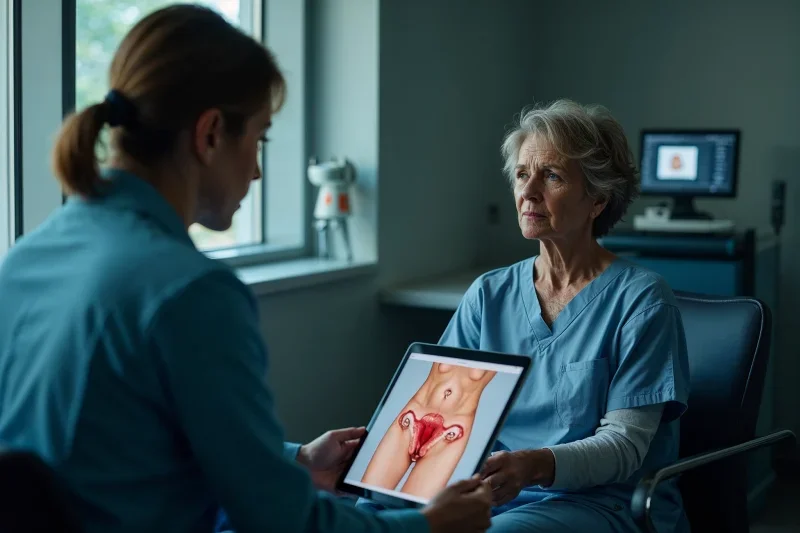Robotic Brilliance With a Price: Discussing the Financial Aspects
Categories:
By: Ethan Cole
Robotic-assisted surgery offers precision and efficiency but requires a significant initial financial investment for acquisition and maintenance.
Despite high upfront costs, robotic surgery can lead to long-term savings through reduced complications and shorter hospital stays.
The costs of robotic surgery not only include the equipment but also installation, maintenance, staff training, and software updates.
Economic barriers and financial constraints restrict many healthcare institutions, especially smaller facilities, from adopting this advanced technology.
Advances in technology and the growth of affordable robotic solutions are expected to lower costs, thereby increasing accessibility and market competition.
Introduction
While the exceptional proficiency of robotic surgery is revolutionizing healthcare through enhanced accuracy and superior results, it is crucial to consider the associated financial implications. The preliminary financial outlay for this technology can be substantial, potentially amounting to millions for procurement of equipment, installation, and personnel training. Nonetheless, aspects such as diminished complications and abbreviated hospital stays may counterbalance these initial expenses over a period, offering potential long-term financial benefits. A comprehensive examination of the economic panorama surrounding such sophisticated technology could provide you with additional insights, facilitating a deeper understanding of the considerable investment required.
Introduction to Robotic-Assisted Surgery
You’ve witnessed the evolution of surgical technology, but nothing quite matches the game-changer that is robotic-assisted surgery. Imagine a world where precision, efficiency, and minimized invasiveness are the norm in surgical procedures. That’s exactly what robotic surgery brings to the table, revolutionizing the healthcare landscape.
The Evolution of Surgical Technology
Delving into the evolution of surgical technology, we find ourselves in the fascinating world of robotic-assisted surgery. This tech marvel brings precision, efficiency, and improved patient outcomes. However, robotic surgery costs can be exorbitant, raising concerns about accessibility and cost-effectiveness.
You might wonder about the economic aspects of robotic surgery. The initial outlay can easily run into millions, reflecting the high cost of acquiring, maintaining, and upgrading surgical robots. Yet, a careful evaluation reveals potential for long-term savings. Fewer complications, shorter hospital stays, and quicker recoveries mean cost reductions in post-surgery care.
Looking ahead, the economic future of robotic healthcare appears promising. With ongoing advancements, costs are expected to decrease, making it a more viable option. Additionally, as the technology becomes more prevalent, the market will likely become more competitive, driving prices down further.
Why Robotic Surgery Represents a Game-Changer
Often, it’s easy to overlook the monumental shift that robotic-assisted surgery represents in the medical field. This technology isn’t merely a new tool; it’s a game-changer reshaping how surgeries are performed and perceived.
You might ask, why does robotic surgery represent such a game-changer? The answer lies in the precision, miniaturization, and decreased invasiveness it offers. These advantages lead to shorter hospital stays, faster recovery times, and less physical trauma for patients. As a result, global trends in robotic surgery adoption are on the rise.
However, it’s not all rosy. There are considerable financial challenges in robotic-assisted surgery. High costs of acquisition, maintenance, and training can be prohibitive, especially for smaller medical facilities. These factors may slow down widespread adoption, despite the clear benefits.
The Value Proposition of Robotic Surgery
Let’s turn your attention to the unique value proposition of robotic surgery. Imagine the benefits of precision and accuracy in complex surgeries, leading to improved patient outcomes and quicker recovery times. Consider, too, the long-term advantages of this technology compared to traditional methods.
Precision and Accuracy in Complex Surgeries
Nearly all complex surgeries demand an exceptional level of precision and accuracy, and that’s where robotic surgery plays a pivotal role. Balancing innovation and affordability in healthcare, robotic surgery emerges as a fascinating synthesis of advanced surgical innovation costs and potential savings.
The cost comparison between robotic and traditional surgery is significant. Initially, the investment in robotic technology may seem colossal, but it’s important to evaluate the bigger picture. Even though the upfront costs are higher, the precision and accuracy offered by these advanced systems can potentially minimize complications, reducing long-term healthcare costs.
Robotic surgery is not simply a luxury; it’s a practical, powerful tool that can make the difference between success and failure in complicated procedures. The ability to perform intricate tasks with unparalleled steadiness can lead to fewer errors and, consequently, fewer repeat surgeries. This not only saves resources but also reduces patient recovery time and discomfort.
Improved Patient Outcomes and Faster Recovery
Imagine speeding up recovery times and enhancing patient outcomes with the aid of robotic surgery. It’s not a far-off concept, but a tangible reality. With the precision it offers, this advanced surgical method is increasingly being utilized, and it’s changing the game when it comes to patient recovery.
Robotic surgery can considerably reduce costs in advanced surgical procedures. By minimizing the invasiveness of the operation, it reduces time spent in hospital, translating to lower overhead and operation costs. You’re fundamentally getting more value for your money, without compromising on quality of care.
But what about patient benefits vs. robotic surgery costs? Well, let’s consider the bigger picture. Faster recovery means less time off work, less discomfort, and a quicker return to normalcy. These are major pluses that, while not directly monetary, have immense value to patients.
Affordable robotic surgery solutions are also cropping up. As technology continues to advance and market competition intensifies, the price point is gradually becoming more accessible. It’s a considerable stride toward making this high-value, high-impact surgical method available to more patients, further enhancing healthcare outcomes.
Long-Term Benefits vs. Traditional Methods
Often, you might question if the initial investment in robotic surgery is worth it, especially when compared to traditional surgical methods. It’s natural to be skeptical when the operational costs in robotic surgery systems seem high upfront. However, it’s important to look beyond the immediate costs and consider the long-term value proposition.
The financial sustainability in robotic healthcare systems is rooted in long-term savings from robotic surgery. These savings emerge from shorter hospital stays, fewer complications, and quicker patient recovery times. This means that while the initial investment might seem steep, the returns on investment quickly balance out the costs.
Moreover, the precision and efficiency of robotic surgery reduce the chances of readmissions and additional surgeries. This leads to further savings in the long run. Plus, as robotic technology continues to advance, the cost of implementing and maintaining these systems is expected to decrease, making it an even more viable option for healthcare facilities.
The Components of Robotic Surgery Costs
Now, let’s move on to the financial side of things, specifically, the components of robotic surgery costs. These costs aren’t just about purchasing advanced robotics equipment and installation. They also encompass ongoing maintenance, software updates, supporting infrastructure, and the training requirements for medical personnel.
Advanced Robotics: Equipment and Installation
While you might think robotic surgery is all about the robot, there’s more to the financial story. The accessibility of robotic surgical technology is a major factor in the overall cost. High-quality robotic surgical systems are a sizable investment, and it’s not just the machinery itself you’ll be paying for.
The initial outlay for the robotic equipment is only the first part of the equation. This includes the cost of the robot, which can run into the millions, as well as the specialized surgical instruments needed to operate it. But don’t forget, this cutting-edge technology needs a suitable environment to function efficiently.
The installation process is another significant cost. It involves setting up the robot in an operating room, which needs certain modifications to accommodate the new technology. Specialized air conditioning systems, electrical upgrades, and radiation protection are just a few of the necessary adjustments.
Lastly, your staff needs to be trained to operate and troubleshoot the robotic system, adding to the initial expenses. The cost of training can be hefty, depending on the complexity of the system and the level of expertise required. This is essential to guarantee the effective utilization of the robot, enhancing the return on this significant investment.
Ongoing Maintenance and Software Updates
Consider this: you’ve invested in a top-of-the-line robotic surgical system, had it installed, and trained your staff. Now, you’re standing at the precipice of another significant aspect of robot-assisted surgery - ongoing maintenance and software updates.
It’s not just a one-time purchase; it’s a continuous investment. These cutting-edge machines require regular maintenance to keep them in peak condition. Just as you wouldn’t let your luxury car run without regular tune-ups, you can’t afford to neglect your high-tech surgical equipment.
Moreover, software updates are essential to keep your robotic system up-to-date with the latest advancements in surgical technology. They’re a fundamental part of the financial equation, and they aren’t optional. Falling behind on updates could mean missing out on critical enhancements, potentially compromising patient safety and surgical outcomes.
Supporting Infrastructure and Training Requirements
Beyond the maintenance and software updates, there’s another significant part of the investment to acknowledge - the necessary supporting infrastructure and the training requirements.
You’ll need to equip your facility with additional hardware for the robotic system to function seamlessly. This includes adequate power supply, reliable network connectivity, and physical space, which often requires remodelling of existing surgical suites. The costs associated can be substantial, but they’re essential for ensuring the smooth operation of the robotic system.
Training is another significant cost you can’t overlook. Your surgical team needs to be proficient in operating these advanced machines. It’s not just about knowing how to use the robot; it’s about understanding the subtleties that come with this new form of surgery. This involves intensive training programs and continuous education to keep up with technological advancements. The costs for such programs can be high, but they’re an investment in your team’s skills and the overall safety of your patients.
Call now to schedule an appointment with Dr. Jason Neef and explore your fertility options.
Comparing Costs Between Robotic and Traditional Surgeries
You might think robotic surgeries are more expensive due to costs like equipment, training, and surgical time. However, don’t overlook the potential indirect savings, such as reduced complications and shorter hospital stays. Additionally, consider the hidden value of minimally invasive procedures when comparing costs between robotic and traditional surgeries.
Direct Costs: Equipment, Training, and Surgical Time
When delving into the direct costs of robotic surgeries, we must take into account several key factors such as equipment costs, training expenses, and surgical time. Robotic surgery equipment doesn’t come cheap. The initial investment can run into millions of dollars, making it a significant financial undertaking.
Moreover, the training required to effectively operate these machines adds to the cost. Surgeons and medical staff need specialized training to guarantee they can use the equipment safely and effectively. This process is both time-consuming and expensive, often requiring travel to specialized training centers.
Lastly, let’s consider surgical time. While it’s true that robotic surgeries can sometimes be quicker than traditional methods, this isn’t always the case. In fact, some robotic procedures can take longer, especially in the early stages of a hospital’s adoption of the technology.
Indirect Savings: Reduced Complications and Shorter Hospital Stays
While the direct costs of robotic surgeries may appear steep at first glance, it’s worth taking a look at the indirect savings that this technology can bring. Robotic surgeries, though expensive, can notably reduce the likelihood of complications and minimize hospital stays, leading to considerable indirect savings.
Consider the risk of infection, a common concern in any surgery. Robotic surgeries are typically less invasive, and as a result, they can greatly decrease this risk. Fewer complications translate to fewer postoperative visits, less need for additional treatments, and more importantly, less discomfort for you.
Moreover, the precision of robotic surgeries often results in shorter recovery periods. This means you could be out of the hospital quicker than with traditional surgeries. Shorter hospital stays not only reduce your bill, but also mean less time off work, fewer disruptions to your life, and a faster return to your normal activities.
The Hidden Value of Minimally Invasive Procedures
In the world of surgery, the adage “time is money” rings particularly true. As you consider the costs of traditional versus robotic surgeries, you mustn’t overlook the hidden value of minimally invasive procedures.
Robotic surgeries, by their very nature, are less invasive than traditional methods. They require smaller incisions, meaning less trauma to the body and a quicker healing process. You’ll find that patients undergoing robotic surgeries often have shorter hospital stays, which translates to lower hospital costs. They’re back to their normal routines quicker too, leading to less time off work and a quicker return to productivity.
The financial benefits don’t stop there. You’ll also see a reduction in post-operative complications. With fewer complications, there’s less need for costly follow-up treatments and medications. That’s a value that’s hard to quantify but significant nonetheless.
Challenges in Affording Robotic Surgical Systems
You might wonder why robotic surgical systems aren’t more widespread. It’s not just about the technology, but also the financial challenges healthcare institutions face, disparities in accessibility across different regions, and how these factors impact patient decision-making. Let’s unpack these issues to better understand the obstacles in affording these high-tech systems.
Economic Barriers for Healthcare Institutions
As a hospital administrator, imagine looking at your operating budget and seeing the staggering costs of acquiring a robotic surgical system. You’re not alone in this predicament. High upfront costs of these systems are a significant economic barrier for many healthcare institutions. The price tag can be as high as two million dollars, not including the ongoing maintenance costs and training expenses.
Yet, you can’t ignore the potential benefits of this technology, from increased precision in surgeries to minimized invasiveness. But the question remains: How can you balance the financial constraints with the need for technological advancement?
You may consider options like leasing the equipment or entering a shared-cost agreement with other hospitals. But these alternatives also have their own set of challenges. Leasing can lead to long-term financial strain, while shared-cost agreements require coordination and compromise on usage times.
The conundrum is clear: adopting robotic surgical systems brings undeniable benefits, but the financial burden can be overwhelming. This economic barrier is a significant hurdle that many healthcare institutions must confront in their journey towards the adoption of robotics in healthcare.
Disparities in Accessibility Across Regions
Imagine a world map, splattered with splotches of color indicating the availability of robotic surgical systems. It’s a picture of high-tech hope, but it’s not evenly distributed. Some countries are vibrant with technicolor, while others are visibly faded. This disparity in access can create significant regional inequalities.
You must understand that the uneven distribution of these medical marvels isn’t due to a lack of interest or need. Rather, it’s a direct consequence of the financial hurdles that many regions face. The cost of procuring and maintaining these robotic systems is astronomical, often reaching into the millions. For some areas, especially those with unstable economies or lower income levels, these costs are simply insurmountable.
What’s more, the cost of training medical professionals to use these systems adds another layer of financial burden. It’s not just about buying the robot; it’s about ensuring a skilled workforce to operate it.
This disparity in access to robotic surgical systems can perpetuate existing health inequalities, with wealthier regions reaping the benefits while others are left behind. It’s a stark reminder that while technology can offer solutions, it can also create new challenges.
The Impact on Patient Decision-Making
Surprisingly, a significant number of patients are forced to weigh the potential benefits of robotic surgical systems against their financial realities. You may find yourself in this predicament, juggling the prospect of advanced surgical precision with the intimidating cost implications.
Robotic systems, while drastically improving outcomes, are notoriously expensive. The hefty price tag often becomes a key factor in your decision-making process. It’s not just about the surgery itself, but also the potential for quicker recovery times, less pain, and fewer complications that robotic surgery offers. However, the cost can be prohibitive, making you question whether the benefits outweigh the expense.
Moreover, insurance coverage for robotic surgeries isn’t always guaranteed. It’s essential to scrutinize your insurance policy, understand what’s covered, and what’s not. You’ll need to factor in potential out-of-pocket expenses, which can escalate quickly.
Regional and Global Perspectives on Robotic Surgery
Let’s now shift our focus to regional and global viewpoints on robotic surgery. You’ll notice differences in adoption rates between developed and developing nations, and the impact of public versus private healthcare systems. We’ll also explore cross-border innovations and how they’re being leveraged to drive down costs.
Adoption Rates in Developed vs. Developing Nations
While developed nations have been swift to embrace the advancements in robotic surgery, many developing countries are still on the periphery of this medical revolution. You might wonder why this is the case. It’s not just a matter of technological availability, but also the financial aspects that deter these nations from adopting this cutting-edge technology.
The cost of acquiring, maintaining, and operating robotic surgery systems can be staggering, often running into millions of dollars. This can be a significant hurdle for countries with limited healthcare budgets. The lack of trained personnel is another major barrier. Robotic surgery requires a specialized skill set, and the training can be expensive and time-consuming.
Yet, it’s not all doom and gloom. International collaborations and funding initiatives are starting to bridge this gap. The developed nations are partnering with their developing counterparts, providing financial and technical assistance to help them leapfrog into the era of robotic surgery.
It’s a slow process, but it’s happening. As you explore deeper into the domain of robotic surgery, you’ll find that it’s a sphere of vast potential, but one that comes with its own set of challenges.
The Role of Public vs. Private Healthcare Systems
You might be wondering how the public and private healthcare systems impact the adoption of robotic surgery. Well, it’s all about the resources available and the priorities set. In public healthcare systems, funding tends to be tighter and the focus is often on providing basic, essential care. Robotic surgery, with its high costs and need for specialized training, might not make the cut.
Conversely, in private healthcare systems, there’s often more scope for investment in state-of-the-art technology. Providers want to attract patients with the latest treatments, and if they can charge a premium for robotic surgery, they’re likely to do so.
But it’s not just a question of money. It’s also about attitude. In countries where the healthcare system is mainly private, there may be a greater willingness to embrace innovation and take risks. In contrast, public systems may be more conservative, preferring tried-and-tested methods over new ones.
In essence, the type of healthcare system can greatly affect the adoption of robotic surgery. But whatever the system, it’s clear that for robotic surgery to become widespread, it has to be both affordable and demonstrably better than traditional methods.
Cross-Border Innovations to Reduce Costs
As we traverse the globe, innovations in robotic surgery are emerging from different regions, each with unique strategies to mitigate costs. Let’s take a look at some of these cross-border innovations.
In the U.S., you’ll find tele-robotic surgery, which allows a specialist to perform surgery from a remote location. It’s not only innovative but cost-effective, reducing travel expenses for both doctors and patients.
Europe is leveraging collaborations between public and private sectors. The UK’s NHS, for example, is partnering with technology companies to develop affordable robotic systems. This synergy reduces R&D costs and accelerates the introduction of new technology into the healthcare system.
Asia, on the other hand, is capitalizing on mass production. Companies in China and Korea are manufacturing low-cost robotic surgical systems, greatly reducing purchase and maintenance costs.
Lastly, Africa is integrating mobile technology with robotic surgery. Mobile health (mHealth) platforms are enabling remote consultations and preoperative planning, cutting down on unnecessary hospital visits, and thereby costs.
As you can see, geographical boundaries are no obstacle for innovation in cost reduction strategies. These cross-border initiatives are paving the way for affordable, accessible robotic surgery worldwide.
The Future of Robotic Surgery Economics
You’re now stepping into the future of robotic surgery economics. Think about how emerging technologies are driving cost reductions and the collaborative efforts to expand global accessibility. Consider, too, the role of artificial intelligence in cost optimization within this exciting and transformative field.
Emerging Technologies Driving Cost Reductions
Robotics’ relentless march toward innovation is driving a revolution in the economics of surgical procedures. Emerging technologies are spearheading this shift, and you’re on the forefront of this fascinating evolution.
Consider miniaturization, for instance. As robots shrink, they’re becoming more affordable. Smaller robots use less material, reducing production costs. They’re also more transportable, slashing shipping costs. Additionally, their compact size means they occupy less space in hospitals, saving money on storage.
Automation is another game-changer. Robots are taking over routine tasks, allowing human resources to focus on complex, higher-value tasks. This not only improves efficiency but also reduces labor costs, bringing down the overall cost of surgery.
Artificial intelligence (AI) is the third pillar driving cost reductions. Using AI, robots can learn from each surgery, improving their precision and reducing errors. Fewer errors mean fewer complications, resulting in shorter hospital stays and lower healthcare costs.
Collaborative Efforts to Expand Global Accessibility
Looking ahead, the future of robotic surgery economics hinges on our collective efforts to make this life-saving technology accessible to everyone, everywhere. You can play a role in this. Imagine networks of researchers, governments, and private organizations working together to bring the miracles of robotic surgery to remote corners of the world.
Here’s the challenge: Robotic surgery is expensive. The machines themselves cost upwards of a million dollars, and that’s before the costs of operation and maintenance. But don’t be disheartened. There are ways to navigate this obstacle.
Increasingly, we’re seeing the rise of public-private partnerships, pooling resources and expertise to expand access. Additionally, we’re witnessing the development of lower-cost alternatives to traditional surgical robots. You’ll be amazed at the innovation that’s happening.
What’s more? Advocacy and education are key. We need to inform policy makers and the public about the benefits of robotic surgery, dispelling myths and misconceptions.
The Role of Artificial Intelligence in Cost Optimization
Almost every facet of our lives is already touched by artificial intelligence, and the field of robotic surgery is no exception. AI’s role in cost optimization can’t be ignored. You’re likely familiar with the high costs of surgical procedures, but imagine a future where AI-driven robotic surgeries could greatly lower these costs.
AI’s potential to streamline the surgical process is massive. It can perform tasks such as preoperative planning and postoperative assessments more efficiently, reducing the time spent in the operating room. This could lead to lower hospitalization costs and reduced healthcare expenses for patients.
Moreover, AI’s precision can minimize surgical complications, decreasing the need for costly repeat surgeries. It’s also worth noting that AI could reduce reliance on highly specialized surgeons, further driving down costs.
However, it’s essential to consider that these savings aren’t guaranteed. The development and maintenance of AI technology itself is costly. And while AI has the potential to reduce costs in the long run, the initial investment may be substantial.
Conclusion
In the domain of finance and robotics, you’ve seen how the two can intertwine and create an impact. You’ve understood the hefty price tags for robotic brilliance and how it’s justified by the potential for increased efficiency and profitability. You’ve recognized the role of artificial intelligence in cost optimization, revealing the potential for immense savings and elevated performance.
It’s clear that the financial implications of robotics are both an investment and a calculated risk. The upfront costs may be substantial, but the long-term potential for profit can offset these initial expenditures. With Dr. Jason Neef, we believe in leveraging cutting-edge robotics to deliver unmatched precision and efficiency, ensuring that every investment in technology ultimately benefits our patients and their outcomes.
Make an appointment with Dr. Jason Neef today to discuss your path to parenthood.
Call (817) 568-8731Categories:
Frequently Asked Questions
-
Machine learning allows businesses to automate complex processes, leading to enhanced productivity and improved decision-making. This transformation helps industries achieve significant productivity gains while maintaining a competitive edge in the global economy.
-
AI adoption in the labor market raises concerns about the risks associated with job displacement and the creation of new jobs. Balancing ethical implications with the potential impact of AI solutions is critical for a sustainable digital transformation.
-
AI-powered tools like natural language processing and machine learning models enable personalized customer service in financial services, offering real-time assistance and tailored financial advice, which improves the overall customer experience.
-
The adoption of automation in production lines enhances efficiency but may shift the job market dynamics. While some roles are replaced, AI can help create new jobs in programming, AI system management, and advanced AI development.
-
The COVID-19 pandemic forced businesses to embrace AI applications for remote work, healthcare, and supply chain management. This incremental shift has further demonstrated how AI is used to shape the future of the digital age.
-
AI algorithms analyze vast datasets in real-time, allowing traders and investors to identify trends, mitigate risks, and maximize opportunities. This capability has become an integral part of financial services and capital markets.
-
Tech giants rely on AI tools for product innovation, predictive analytics, and global scaling. These tools continue to push the boundaries of what's possible, unlocking new avenues for future growth in the global economy.
-
AI adoption has become a part of our daily routines, enhancing convenience through applications like virtual assistants and personalized ads. It also fuels future results in the economy, driving innovation and efficiency.
-
The risks associated with AI solutions include data breaches, algorithmic bias, and over-reliance on AI-powered systems. Ensuring robust security and transparency is essential for sustainable digital transformation in financial services.
-
Future research can explore the potential impact of advanced AI on society, identify new avenues for ethical AI deployment, and reflecting a bullish outlook for industries adopting AI in various applications.











